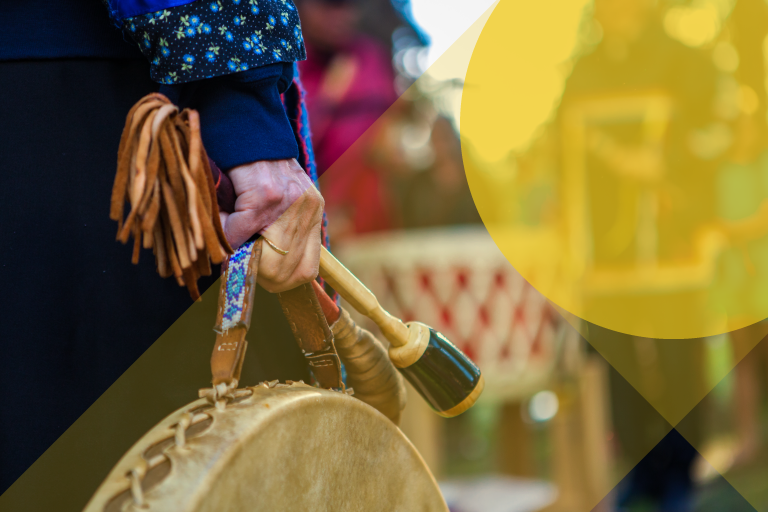It’s officially November and, as the leaves change and we turn our clocks back, it’s important to reflect upon, pay respect to, and raise awareness of Indigenous communities. During Native American Heritage Month we want to share some inclusive marketing tips that focus on using the right language and terminology as well as how we can pay homage to the land we live on. Let’s start at the beginning.
The History of Native American Heritage Month
November has been nationally recognized as Native American Heritage Month for almost 30 years. Native American Heritage Month first appeared on calendars back in 1915. Before 1915, Director of the Museum of Arts and Science in Rochester, New York, Dr. Arthur C. Parker, a Seneca Indian, asked the Boy Scouts of America to dedicate one day a year to the “First Americans.”
Then, in 1915 the Congress of the American Indian Association directed its president, Rev. Sherman Coolidge, an Arapahoe, to do the same. Coolidge then issued a proclamation that said the second Saturday of each May would be American Indian Day and also “contained the first formal appeal for recognition of Indians as citizens.”
While some states have observed American Indian day since the early 1900s, it wasn’t formally recognized as a national holiday. But, in 1990 George H. W. Bush approved a joint resolution, making November Native American Indian Heritage Month. Plus, “similar proclamations, under variants on the name (including ‘Native American Heritage Month’ and ‘National American Indian and Alaska Native Heritage Month’) have been issued each year since 1994.”
With this month being about paying respect to the Indigenous American people, we wanted to explore ways to do just that.
Using the Right Language
Marketers, especially content marketers (hi!), know the importance of using the right language to get a certain message across. When writing about heritage months or months dedicated to certain groups of people or cultures, it’s critical that we use respectful language.
As a Broader Group
Firstly, is Native American even the preferred language? According to the National Museum of the American Indian, “When possible, Native people prefer to be called by their specific tribal name.” However, when not possible, American Indian, Indian, Native American, Indigenous, or Native are all accepted.
Native American, however, is becoming a less popular choice. As the National Museum of the American Indian says, “Native American has been widely used but is falling out of favor with some groups, and the terms American Indian or Indigenous American are preferred by many Native people. Native peoples often have individual preferences on how they would like to be addressed.“
By Tribe
The National Park Service also published an informational page about Native American Heritage Month that specifically mentions the importance of word choice and how to refer to the Indigenous American people. They mention that those referring to the Indigenous American people need to be cognizant of distinctions between tribes. “There are distinctions among various tribes resulting from geographic location, language, and cultural practices. For example, within the Lakota Nation (aka Sioux), there are seven bands and within one band there are three: Hidasta, Arikara, and Mandan.”
Territorial Acknowledgements
The National Park Service brings up the point of tribal distinctions due to many factors, one of which is geographic location. As the Administration for Native Americans highlights, “[today] there are 325 American Indian reservations and a total of 618 legal and statistical areas for which the Census Bureau provides statistics, including reservations, off-reservation trust lands, Oklahoma tribal statistical areas, tribal designated statistical areas, state American Indian reservations, and state designated American Indian statistical areas.”
With so many reservations, legal areas, and statistical areas in the United States, we need to be aware of the land we are using and offer territorial acknowledgements, when applicable.
What is a Territorial Acknowledgment?
Really, a territorial acknowledgement is just what it sounds like—acknowledging the territory you are in and the tribes that currently reside there or have resided there in the past. As native-land.ca says, “This is often done at the beginning of ceremonies, lectures, or any public event. It can be a subtle way to recognize the history of colonialism and a need for change in settler colonial societies.”
The site also points out that a territorial acknowledgement can often be thrown in as a token rather than as a way to fully respect the indigenous cultures that came before. When giving a territorial acknowledgement—whether as an individual, institution, or even as a brand—you also need to recognize the history and legacy of colonialism.
Some questions to ask yourself (as provided by native-land.ca):
- What are some of the privileges settlers enjoy today because of colonialism?
- How can individuals develop relationships with peoples whose territory they are living on in the contemporary geopolitical landscape?
- What are you, or your organization, doing beyond acknowledging the territory where you live, work, or hold your events?
- What might you be doing that perpetuates settler colonial futurity rather than considering alternative ways forward?
- Do you have an understanding of the on-going violence and the trauma that is part of the structure of colonialism?
If you’re curious about the tribes around you, on native-land.ca you can search your address to learn more about the tribes in your area.
Words Are Impactful
We need to make conscious efforts to choose respectful language when referring to any cultural, racial, or ethnic group. This should also be the case year-round, and not just within the groups’ respective heritage months.
During Native American Heritage Month we can pledge to learn something new about the Indigenous American people and use that new knowledge to inform how we move about the world every day.






























